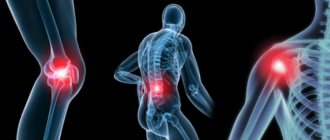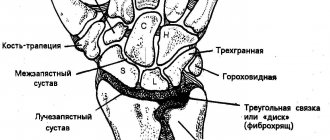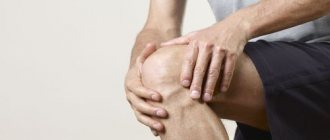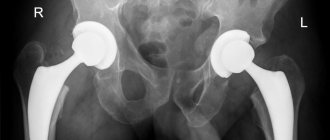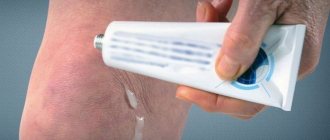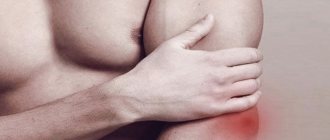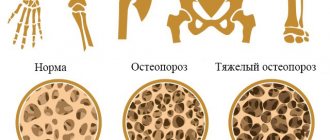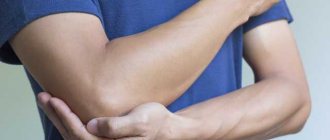Synovitis of the knee joint is an inflammatory process limited to the joint membrane of the lower limb. A characteristic feature of the development of the pathological process is the accumulation of fluid in the joint, which significantly reduces the functionality of the knee.
Among the key reasons are previous injuries, as well as other joint pathologies and various metabolic disorders, including infectious lesions.
The main clinical manifestations are pain, the intensity of which increases when attempting to perform a movement, as well as swelling and an outwardly noticeable increase in the size of the localization site.
The diagnosis is made based on the patient’s existing complaints, visual examination, as well as the results of the study (laboratory/instrumental).
The treatment plan for each patient is determined individually, in accordance with the existing symptoms and his state of health.
What is synovitis of the knee joint?
Synovitis of the knee joint is a common pathological inflammation, the development of which results in the accumulation of fluid that can become purulent. Synovitis belongs to the category of serious pathologies that require timely diagnosis and an integrated approach to treatment.
The pathological process occurs mainly as a result of trauma or as a concomitant inflammation with arthrosis.
It is important to note that synovitis is not an independent disease, but only becomes the result of other general or local pathologies.
Consequences and prognosis
If synovitis is treated untimely and incompetently, the consequences can be dire. For example, it will develop: periarthritis, gonarthrosis, osteoarthritis, phlegmon, purulent panarthritis or arthritis. Pus penetrates the joint capsule, bone rotting and sepsis begin. All this ultimately ends in disability and even death of the patient.
The prognosis in case of treatment of synovitis and compliance with all doctor’s instructions is quite favorable. Joint mobility is restored and relapses are extremely rare.
Causes of synovitis of the knee joint
The most likely causes of synovitis of the knee joint are destructive changes occurring in the connective tissues. A change in the structure of the synovial bursa certainly leads to the accumulation of fluid inside it. Prolonged exposure to excessive amounts of fluid can cause inflammation.
Among other causes of synovitis of the knee joint, it is customary to identify factors such as:
- increased physical activity;
- excessive physical activity;
- metabolic disorders;
- the presence of severe systemic diseases;
- repetition of monotonous movements that injure connective tissues.
Nutrition
The fundamental principles of treating synovitis include diet:
- Gradual weight loss is a prerequisite for successful therapy. Losing weight reduces the stress on your joints.
- Eat frequently 4-5 times a day, but in small portions, consume protein of animal or plant origin daily: meat, beans, lentils.
- Carry out fasting days once a week - a diet in the form of fruits, vegetables, lactic acid products.
- Normalize metabolic processes - exclude grape acids and easily digestible carbohydrates from the diet: chocolate, grapes, wine. Eat seafood, seaweed, plant foods, especially red and green vegetables.
Salt - of course, you don’t need to completely give it up, but reduce your consumption to 1 gram. per day is necessary.
Varieties
The disease belongs to the category of pathologically dangerous, the lack of timely diagnosis and treatment of which can lead to serious impairments in a person’s life activity and quality of life.
Today, it is customary to distinguish several types, each of which has specific symptoms and prognosis. Let's look at each type in more detail.
Spicy
A type of pathology involves the accumulation of a large amount of fluid, which contains a large amount of proteins and blood impurities. Overfilling of the synovial bursa leads to swelling of its walls, which provokes pain of varying intensity.
Chronic
Synovial fluid contains a high concentration of fibrillar proteins, which indicates irreversible processes occurring in the tissues of the joint membrane.
Destruction of the internal cavity of the joint capsule leads to compaction of the tissues of its walls, which causes the formation of intra-articular bodies.
Purulent
Damage to the joint capsule, suggesting the presence of purulent impurities in the synovial fluid, which causes a change in its structure and the onset of the inflammatory process.
Lack of therapy leads to the spread of the lesion to other structural components, provoking the development of acute purulent arthritis.
Diagnostics
Stages of examination of synovitis:
- Anamnesis collection - information about complaints, symptoms, period of illness, lifestyle, past diseases is systematized.
- They will conduct an examination: palpation of the knee joint, gait analysis, and determine the degree of deformation of the knee joint.
- Laboratory diagnostics: examination of synovial fluid (they will take a puncture from the joint), clinical blood test, urine test.
- Instrumental diagnostics: X-ray, ultrasound examination - to determine the degree of deformation, the presence and nature of the fluid.
For treatment, you need to see an orthopedic traumatologist, if not, then see a surgeon.
Bursitis or synovitis - what is the difference?
Bursitis - begins due to inflammation of the joint capsule and the accumulation of exudate in its cavity (this is a liquid with a special biochemical composition).
Synovitis is, as we already understood, inflammation of the synovial joint membrane, with the gradual formation of exudate or transudate in it. Bursitis and synovitis often form together.
Bursitis or synovitis - differences
Meniscitis and synovitis
Meniscitis is a lesion of the meniscus. Complete and sometimes partial pinching of the anterior and posterior horn of the meniscus may occur. And synovitis implies inflammation of the synovial membrane and the accumulation of effusion of various etiologies in it.
Symptoms of synovitis of the knee joint
Common symptoms of synovitis of the knee joint, regardless of the etiology of its origin, include:
- swelling of the affected area;
- visually noticeable increase in the size of the affected area;
- mild/moderate pain;
- feeling of "fullness".
Specific symptoms of synovitis of the knee joint are determined by the type of pathology present and the degree of its development.
Symptoms of acute synovitis of the knee joint
With the development of pathology, the size of the joint of the lower limb noticeably increases in volume. The patient experiences an unpleasant feeling of fullness, as well as pain that intensifies when performing movements. Swelling is observed.
An important symptom is the voting of the patella (with external influence, it moves down until it touches the bone. After the influence stops, it returns to its original position).
In rare cases, general malaise occurs.
The severity of symptoms is determined by the amount of fluid accumulated inside the joint capsule.
Symptoms of chronic synovitis of the knee joint
The pathology of this type is characterized by a wave-like course, in which exacerbation alternates with remissions.
The symptomatic picture during an exacerbation is similar to acute synovitis, but is less pronounced. Additionally, the following may be observed:
- inactivity;
- dull, aching pain;
- increased fatigue when walking at varying intensity.
Symptoms of purulent synovitis of the knee joint
Local symptoms: noticeably enlarged joint, sharp pain, almost complete loss of mobility.
Unlike other varieties, purulent inflammation has clear symptoms, similar to those that occur during intoxication:
- increase in body temperature up to 40°C;
- chills, fever;
- the occurrence of neurological disorders;
- indigestion.
Articular symptoms can also be observed, which usually include swelling of the skin.
Depending on the stage of the disease, we choose one or more treatment methods in Moscow:
Therapeutic massage, osteopathy, manual therapy
Helps bones and joints take the correct physiological position, relieves pain and spasms, relaxes muscles.
Acupuncture in Moscow
Work on biologically active points. It affects the affected area and the body as a whole. Eliminates the cause of the disease and removes the symptoms.
In addition, according to indications, the following are used: taping, pharmacopuncture, FormTotix insoles, exercise therapy with an instructor and other methods. The choice of procedures depends on the current condition; taken together, they act faster and give a more lasting result.
Diagnostic measures
In order to obtain the most accurate diagnosis, when the first signs of an inflammatory process appear, it is recommended to immediately seek professional medical help.
The key diagnostic method is puncture (extraction of a small amount of joint fluid for the purpose of research). The most informative is bacteriological or bacterioscopic analysis of the extracted material.
The type of pathogenic microflora present is determined. It is mandatory to analyze the resistance of identified bacteria to antibacterial agents.
In addition, at the diagnostic stage, instrumental methods are also important, which include:
- arthroscopy;
- arthropneumography;
- CT/MRI.
If there are symptoms suggesting benign or malignant neoplasms, patients are prescribed a biopsy of the affected membrane.
Based on the results obtained, the severity of a particular clinical case is determined, which helps to outline ways to resolve it.
Typology
In medicine, the following classification of synovitis is proposed:
- infectious – there is infection with a pathogen;
- traumatic – due to mechanical injury;
- reactive – develops due to prolonged mechanical trauma, for example, at work (car mechanic, builder, athlete, etc.);
- aseptic – for endocrine diseases (for example, diabetes), blood diseases (hemophilia) and metabolic disorders (gout);
- allergic - allergens affect the synovial membrane when it has increased sensitivity.
To make a correct diagnosis, it is imperative to tell the doctor about all possible signs and sensations during the inflammatory process.
Treatment of synovitis of the knee joint
The pathology is treated by a wide group of specialists at various levels. In acute and purulent types, the patient must be hospitalized.
The first stage is the removal of fluid accumulated inside the joint, and only then complex therapy is prescribed using medications and physiotherapeutic methods.
The main goal of therapeutic treatment is to eliminate the factors that provoke an increase in the volume of joint fluid.
Drug treatment
The use of medications falls into the category of conservative methods and involves puncture with evacuation of accumulated fluid and the use of a number of drugs that eliminate symptoms and help combat the causes.
The following groups of drugs are prescribed as drug therapy:
- glucorticosteroids;
- chondroprotectors;
- painkillers;
- antibiotics.
Particular attention should be paid to chondroprotectors, the use of which can accelerate the process of tissue regeneration. One of the most effective among them is considered to be the drug “Artracam”.
Physiotherapy
Physiotherapeutic techniques help restore the functionality of the affected joint. Already 3-4 days after the start of treatment, patients are referred to activities such as:
- phonophoresis using corticosteroid drugs;
- UHF therapy;
- therapy using magnetic and electric fields.
Surgical intervention
Radical methods are used in situations where the patient’s treatment is not amenable to conservative methods. Thus, surgical intervention is indicated for recurrent chronic synovitis, the progression of which is accompanied by changes in the tissue of the joint capsule.
Surgery involves partial or complete removal of the inflamed joint membrane.
The postoperative period involves immobilization and the prescription of drug therapy with the use of antibiotics, painkillers and, of course, chondroprotectors, which provide the opportunity to accelerate regenerative processes within the joint tissues.
Therapeutic physical education (PT) as a method of complex treatment of synovitis
The use of exercise therapy complexes is an integral part of complex treatment and allows you to speed up the recovery process, helping to improve metabolic processes within the affected tissues.
A set of exercises is selected individually, in strict accordance with the recommendations of the attending physician.
Preventive actions
There is no way to insure against all diseases, but there are measures to prevent their occurrence, in particular, such an unpleasant disease as synovitis.
Among the most effective methods of prevention are:
- wearing comfortable orthopedic shoes;
- reduction of strong physical activity;
- lesson with a physical therapy instructor;
- maintaining balance in the daily diet;
- giving up bad habits;
- preventive examinations with the attending physician.
Pay special attention to health. At the first signs of pathology, seek medical help and follow all the instructions of your doctor in order to live a full life.
Folk remedies at home
Folk remedies are used as complementary remedies for the treatment of synovitis. With unexpressed synovitis or minor manifestations of symptoms, folk recipes can stop the course of the disease.
Preparation of ointment:
- 0.5 cups vegetable oil;
- 1 tsp. dead bees;
- 1 tsp. propolis;
- 1 tsp. beeswax.
Mix everything and place in a water bath for 20–30 minutes. Remove, stir, let cool and apply to the knee joint overnight, tying it with cotton cloth.
Compresses:
- Pour 1 tbsp into a thermos. l. comfrey herbs , pour a glass of boiling water, leave for 12–14 hours, strain. Soak a cloth in the solution and place it on the sore knee joint.
- Take a clean cabbage leaf , mash it a little, apply it to the knee joint, secure it with a bandage, and insulate it on top. We keep it for a day, then replace it with a fresh one.
- Squeeze the juice from the beets, moisten a cloth with it and apply it to the joint; no need to insulate it. Do it at night.
Bay leaf has an anti-inflammatory and analgesic effect and is used at home in the form of rubs and decoctions.
You can prepare a rub based on bay leaves:
- 2 tbsp. l. bay leaf (chopped).
- 1 cup oil (vegetable, corn).
- Mix and leave for 7-8 days in a dark place.
- Treat and use as a rub.
Laurel decoction:
- Mix 10 g of bay leaf, 300 ml of water and boil for 3–5 minutes, wrap and let steep for 3–4 hours.
- Then strain and drink everything immediately before bed.
- The medicinal properties disappear from storage, so you must always prepare it fresh.
- Drink for 2 days, take a break for a week , then take another 2 days. You can repeat it in a year.


